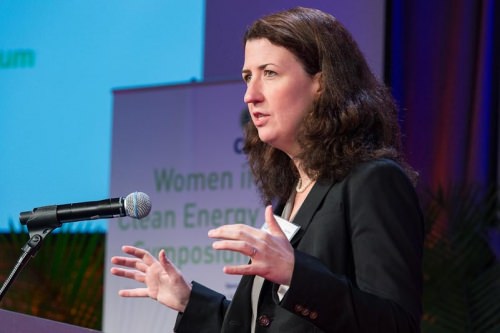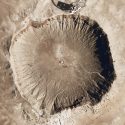Bringing satellites to users can improve public health and safety

The newest Earth-observing satellites deployed by NASA and other agencies around the world are streaming back information about air pollution in nearly real time. NASA Worldview image courtesy of HAQAST
The drumbeat calling scientists to share their work with the public is as loud as ever, and Tracey Holloway is happy to answer. It’s just that education isn’t exactly what she’s offering.
She’s got satellites.
“We have hundreds of millions of dollars’ worth of data from satellites that have been up in space for over 10 years,” says Holloway, a professor of environmental studies at the University of Wisconsin–Madison. “And we know people have problems they want to solve. And we want to know how we can help.”
Holloway leads a group of 13 researchers drawn together as NASA’s Health and Air Quality Applied Sciences Team (HAQAST) who are trying to step outside their community of atmospheric scientists and satellite experts to provide space-based tools to relative laypeople — and to put those new users in a position to shape the way satellite data is collected and used.

“We have hundreds of millions of dollars’ worth of data from satellites that have been up in space for over 10 years,” says Tracey Holloway. “And we know people have problems they want to solve. And we want to know how we can help.” Photo: U.S. Department of Energy
Holloway presented HAQAST’s brand of public engagement here Feb. 16 at the annual meeting of the American Association for the Advancement of Science.
“The traditional model of science outreach moves in one direction: scientists disseminating information,” says Holloway. “What’s unusual about our experience with HAQAST is that we’re building a two-way dialogue to move the research along and to make sure that the research is addressing questions of social value.”
The newest Earth-observing satellites deployed by NASA and other agencies around the world are streaming back information about the air we breathe in nearly real time, and with coverage that dwarfs ground-based sensors. They can see atmospheric pollutants like nitrogen dioxide — NO2, a lung irritant that also forms the problematic greenhouse gas ozone — and dust and smoke from storms and fires.
“A big question is how air quality is changing in areas where we don’t have ground monitors,” says Holloway. “States in the Western U.S. may only have one or two monitors, and only in major cities. But there are two instruments in space that can see NO2 concentrations in the atmosphere, and they see the whole world once a day.”
That could be a boon for lawyers, urban planners and doctors tasked with air pollution management and public health decisions trying to track air quality shifts in rural and even suburban areas. But while the satellites take in all the Earth in 24 hours, it can be tough for potential data customers to keep track of cutting-edge science.
“What’s unusual about our experience with HAQAST is that we’re building a two-way dialogue to move the research along and to make sure that the research is addressing questions of social value.”
“The mission for these folks is to do their job — to keep the air clean, to develop good policies, to protect public health, to understand the problem so they can solve it,” says Holloway. “We don’t want to expect them to read our scientific journals, trying to figure out how to use novel data sources in new ways.”
HAQAST is. And their brand of public outreach involves special issues of industry magazines, visits to meetings of professional organizations and state consortiums, social media, and visits with individual agencies and small groups in an effort to remove any and all barriers.
“A lot of people have no idea where the front door is: ‘Can you just call up a scientist?’“ says Holloway. “And they really don’t know if you can ask a scientist to get something you need. We want those questions.”
Planning a new satellite and shooting it into orbit is not a casual enterprise. It takes years, presents hard decisions about which capabilities are worth adding or subtracting, and requires a commitment from researchers like Holloway to interpret — and find new ways to use — the resulting data. NASA’s HAQAST effort helps identify data that users will value, and how to make the best use of the instruments that are already up in space.
“I’m promoting super high-value data that’s readily available online, but I also want those users to help guide our next research questions,” Holloway says. “It takes time to go from a good idea to a published research study — or another instrument in space. Nobody should have to wait 10 years to know how to use data from new-generation satellites.”
“Science is about having good ideas and fresh perspectives to solve problems. It’s hard to do that if you don’t expose yourself to new people and different viewpoints.”
Input from fire chiefs may help NASA provide real-time tracking of smoke plumes from wildfires, and meetings with air quality workers in Maricopa County, Arizona, sparked work by one of Holloway’s graduate students to sharpen the way satellite measurements of formaldehyde in the air are used to track pollutants that can cause smog, make people sick and contribute to climate change.
Stepping outside their usual scientific circles puts the HAQAST members in touch with people who may know plenty about air quality, but from the perspective of a business or policy-maker or doctor or community group, according to Holloway.
“Those members of the public deserve more credit for what their expertise can contribute to the scientific enterprise,” she says. “Science is about having good ideas and fresh perspectives to solve problems. It’s hard to do that if you don’t expose yourself to new people and different viewpoints.”
Tags: environment, pollution, science, space & astronomy



